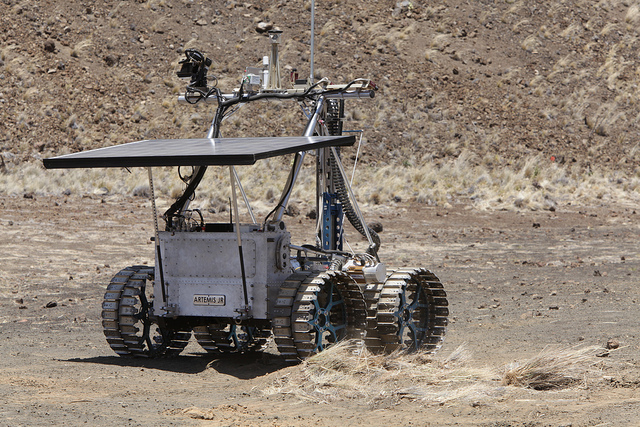NASA is currently building the capabilities for long-term, deep-space human exploration. We know from experience on the International Space Station (ISS) that harnessing and recycling space resources increases mission flexibility, reduces payload mass requirements, and reduces risk to a crew who might otherwise be dependent on a cargo delivery. The ISS Water Recycling System, for instance, leverages local resources by recycling as much water as possible. It recycles urine from waste systems and even moisture from the air. This system is vital to continual operations because the cost of transporting all of the water needed for consumption and waste management is prohibitively expensive.
 Image at right: Sitting atop the Canadian Space Agency’s Artemis Jr. rover, RESOLVE is an experiment package designed to find, characterize and map the presence of ice and other volatiles in almost permanently shadowed areas at the lunar poles.
Image at right: Sitting atop the Canadian Space Agency’s Artemis Jr. rover, RESOLVE is an experiment package designed to find, characterize and map the presence of ice and other volatiles in almost permanently shadowed areas at the lunar poles.
Here in Hawaii, during NASA’s In-Situ Resource Utilization demonstrations, we are simulating a lunar robotic mission with the RESOLVE (Regolith and Environment Science and Oxygen and Lunar Volatiles Extraction) experiment package. It is designed to find, characterize and map the presence of ice and other volatiles on the moon. The last few days, the RESOLVE package, mounted on a Canadian Space Agency rover, has traversed the volcanic deposits of Hawaii’s Big Island and is using several science instruments to locate volatiles in the regolith, drill for samples, then characterize and separate the samples for processing.
Bill Larson, ISRU Technology Development Project Manager, explains how ISRU is a vital component of long-duration missions, offering the analogy of “camping vs. settling” at a destination.
For instance, when you’re camping, you bring canned and perishable food, bottled water, other temporary consumables, and batteries for your flashlight. When you are settling at a new location, you are likely to bring some perishables to sustain you in the beginning, but you’ll also bring buckets to gather fresh water, seeds for a garden, spices to flavor the food you’ll grow, and, instead of batteries, a reusable method of power generation.
In this analogy, you don’t need ISRU for a camping trip, but if you are going to settle a any destination in space and be productive, you need to be able to harness local resources to generate gases and metals for human consumption, building materials, and propellants.
For more information about In-Situ Resource Utilization, visit www.nasa.gov/exploration/analogs/isru.
